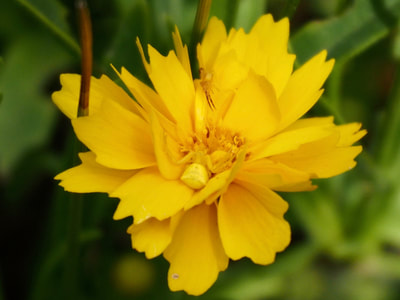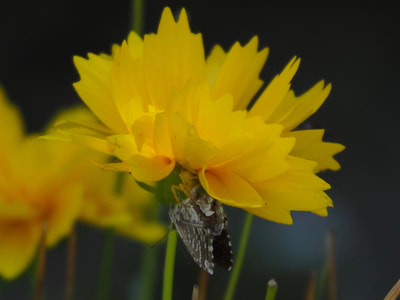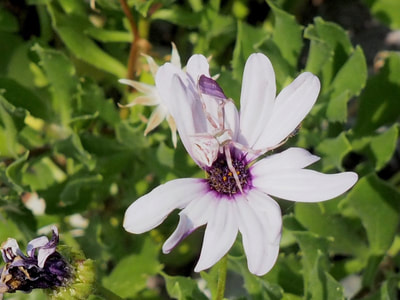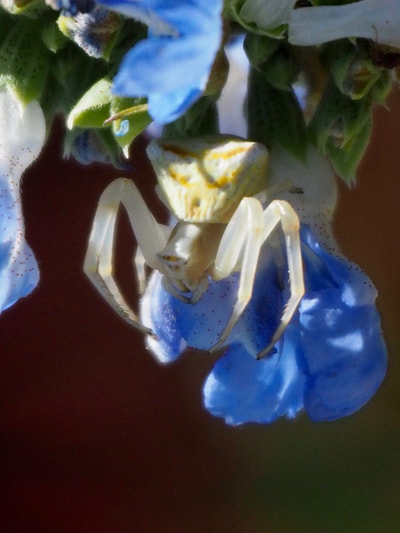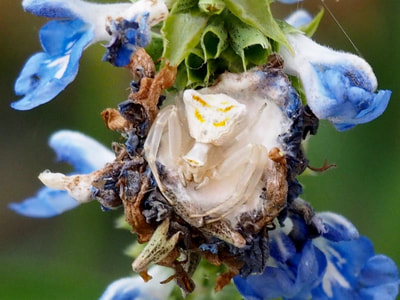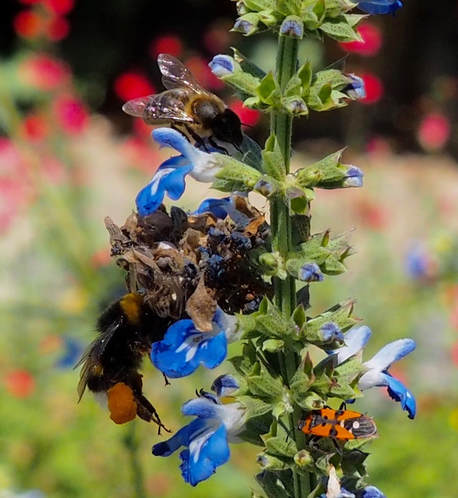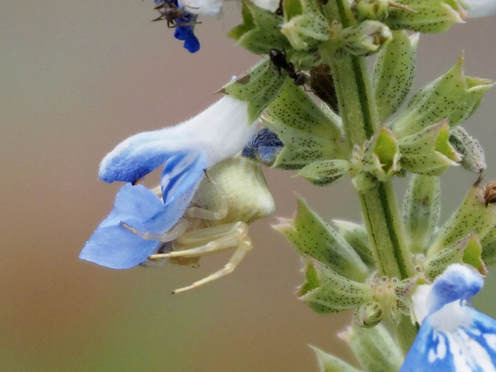I've been frightened of spiders since childhood. When I was six, during a family picnic, one of those tiny-bodied, long-legged ones ran across my hand and onto the strawberry I was about to bite into. Such traumas can mark you for life. Yet here I am now, blogging about arachnids. Crab spiders have especially captured my interest. In June I wrote about a female that proved to be an efficient and formidable bee killer. After she gorged on three in one day, if she was representative of her species I began to worry for the local bee population. However, this was nature at work; intervention on my part, by either destroying or moving her, was out of the question. Instead, I found myself monitoring her behaviour. She intrigued me and, by happy coincidence, had settled on a salvia flower spike that was easy to observe and photograph. Over the coming weeks I would witness far more action than anticipated.
It started slowly, though. The day after her beefest of June 21st, she ate nothing. This was hardly surprising - she must have felt quite bloated. Over the next four days she only caught a small fly and one bee. Then nothing again. I put this down to bad luck and, relieved for the bees, turned my attention to the rest of the garden, where I felt sure I'd find more of her kind.
There was one on the marjoram - a much smaller individual, quite the wrong colour. It must have recently moved from a yellow flower and not yet morphed to pink. Two more turned up in the front garden - a male and female on the same flower. She was quite a bit smaller than the one in the salvia, and he was tiny in comparison with both. Only once did I see one of them (the female) with a kill: a butterfly like the one whose lucky escape I recorded in my June blog.
Click photos for larger image.
I had to find out more. According to the internet, she would have laid eggs on a petal. After having folded and sealed the petal, she would guard the eggs for the next three weeks until they hatched. During this time she would stop eating. Then she would die.
To me this helped explain the beefest: she'd been fattening herself up. Just as female mosquitoes need to suck blood for egg production, so my spider might have had to take in extra food to help her eggs develop. She might also have been building energy reserves to sustain her through the long wait. I suddenly had more respect - as well as some sympathy - for my spider.
On closer inspection she appeared shrunken and much more wrinkled than before. Initially I assumed this was because she was dehydrated, and that she would steadily decline. I've since learned that the weight loss was mainly due to her having offloaded all those eggs. The following photos show her before and after laying.
Click photos for larger image.
The trouble was, although the plant (bog sage - Salvia uliginosa, I think) was perfect for ambushing pollinating insects, it turned out to be a lousy nest site. The thin flower spike she'd chosen, on the outside edge of the plant, had been relatively short when she made her nest close to the tip; within a couple of weeks it had grown to nearly 1.5m and was totally at the mercy of the wind.
Where we live, at the foot of Mt. Neoulous, southerlies can be fiercer than the prevailing north westerly. For several consecutive days they lashed the garden, with the result that the nest came adrift from most of its moorings. What used to be the top was now the side.
I know webs are strong but these silk tethers were being severely tested. How much longer could they last? To my surprise, mother spider never carried out any repairs but clung on, in an increasingly precarious position, until the nest hung almost upside down.
One kill was a big bumblebee with a huge pollen load. It had worked so hard to gather that.
Then one morning I found the nest deserted. I wondered if the spider had herself been predated. Or perhaps the eggs should have hatched by now but were sterile. Had she abandoned them?
None of the above.
She'd been there all the time, superbly camouflaged under a nearby flower. In classic ambush posture - front legs outstretched - she was hungry. After an hour or so, she returned to the nest, still hungry.
On the evening of July 19th, the wind rose again; another fierce southerly whipped itself into a full-blown gale. The nest, hanging by what looked like a single rope of silk, was smacked back and forth, round and round like a swingball on a flower stem post. I found my eyes continually drawn from book or television to living room window. From my chair, I could just make out the nest. At times the whole plant was nearly flattened by a vicious gust, only to bounce back and be swept in the opposite direction.
It was around three weeks since my spider created that bowl of petals. She was so close to success. If she could just get through tonight...
By my bedtime the wind had died. It was dark now, but I had to check. I grabbed a torch and padded across the lawn.
No nest.
Was I looking at the right spike? Of course I was. The nest had gone. Vanished. Obliterated.
Or not.
Presumably Mum would have flown with it, spinning a safety line to save them all. Where could it have ended up? Oh no, I might already have trodden on it - on her - as I crossed the lawn.
I swept the torch across the grass. No flattened nest.
Come the following afternoon, despite feeling rather foolish on my knees, parting blades of grass, peering into and under plants, and lifting leaves blown off the vine, I finally found it. It was close to the ground in the middle of a lavender bush next to the salvia. There was no obvious sign of Mum, so I carefully reached down with a twig, and gently lifted the thin end. She was underneath. In my head, I punched the air. Although she might be more vulnerable to predators at that height (at least two lizards share that border), she would be much more sheltered. I just had to remember not to deluge the bush with water from above.
Like an anxious grandmother-in-waiting, I checked progress each morning for the next three days. Mum was still underneath the nest. Still alive, not eating. Any minute now, surely?
On the fourth day after the gale, I couldn't see so much as an eye or tip of a leg sticking out from under the nest. Carefully, I lifted one end again. Mum had gone. The nest itself looked even more fragile than before - empty, even. Were we a grandmother? I knew the babies would only emerge after their first moult, leaving skin casts behind. Those might be visible. I gently picked the nest up, only to realise it was crawling - with tiny spiderlings.
Now I saw lots of them, everywhere - like white money spiders - running over the nest, my hand, up and down lavender stems and leaves; trampling one another; leaping into the void, trailing a safety line; investigating my camera... Such an exciting new world to explore. And no training required. When stationary, they instinctively adopted ambush position: front legs wide, to fasten on ... a mite?
While watching them - probably with a silly grin on my face - I caught sight of their mother a couple of feet away in the gazania. Very much not dead.
She spent the rest of the afternoon there, finally settling in the bullseye of a sunny flower. I wondered if she'd catch anything because her whiteness starkly contrasted with the petals; it would take her a few days to change. As it turned out, while I was getting my lunch, she caught a small bee. By then I couldn't begrudge another bee death - not after all she'd been through.
I've no idea how many spiderlings emerged, nor how many would have made it through their first day. Not all, I'm sure. That night they experienced their first thunderstorm.
Torrential rain wasn't a problem for Mum. The very next morning she was on another salvia spike. Again she had chosen one on the outermost edge of the plant and, as usual, had set up ambush under a flower facing outwards, towards the lawn. Was this significant? Perhaps she believed that bees might visit the outer flowers first. That would make sense, though I'm not sure it's always the case. I get the impression (probably wrongly) that they tend to head for the tallest stems first - or those with the most open flowers. She was also facing north, north-west - theoretically the shady side of the plant. But the sun is so high for most of the day, I'm not sure this made much difference. Enough of one, perhaps, for a crab spider.
If my eyes didn't deceive me she was now tinged yellow. Her body was still catching up with her day in the gazania. Over the next few hours, while this remarkable creature silently did her thing, the bin lorry screamed past our garden, followed by a hissing street sweeper; a helicopter thundered low overhead; a distant hedge trimmer droned, and kids on holiday squealed and splashed in the neighbours' swimming pool...
Worlds apart. Oblivious of each other, it seemed, except for me standing in between.
I was once again preparing my lunch when the spider grabbed hers. A ginger bumblebee this time - same as the first day I saw her, just over a month ago. Of all the bees that visit my garden, the gingers are my favourites. However, although I mourned the poor thing, strangely, I found myself still rooting for Mother Spider.
Another day on, and she has turned pale green. She's not shrivelled, she's plump and spry. Today, though, due to another high wind, there have been few bees about. No kill.
My latest theory is that the subject of my study left the nest to try and catch prey because she was already pregnant again, and the imperative to feed herself up had been triggered. It's possible that she's now a few days away from producing another brood. If so, has she learned not to nest in salvia? Somehow I doubt it. Absurdly, I can't wait to find out. I also can't wait for delivery of Douglass H. Morse's 392-page book, which should answer more questions than I can possibly dream up about the species.
It's over fifty years since that family picnic, and I'm thinking this crab spider might have cured me of my phobia.
Epilogue: She did go on to successfully raise a second brood (which, according to Morse's book is unusual) after which she disappeared.
Part one of this story can be found here
